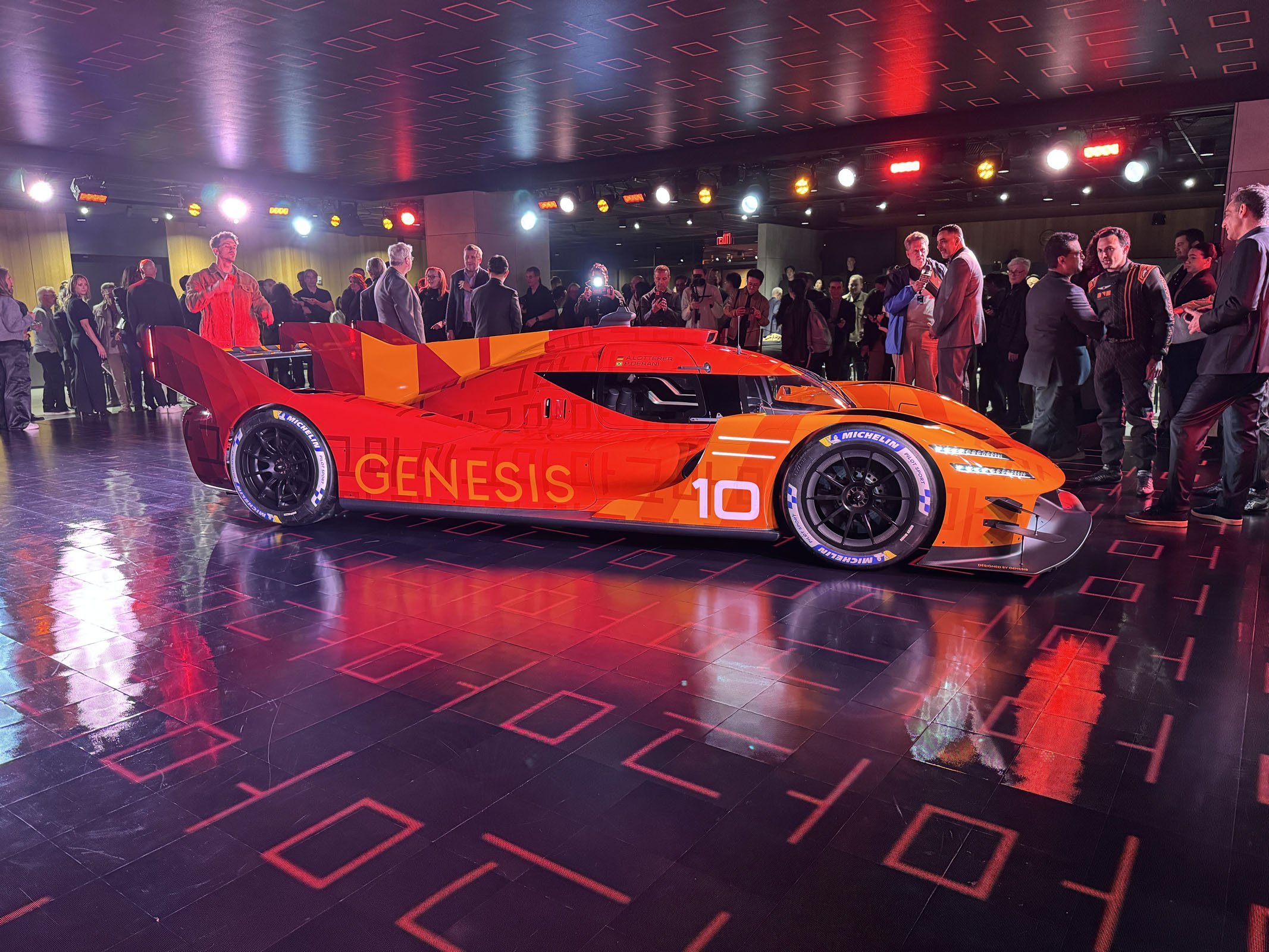Genesis is officially stepping into global motorsport.
The company revealed its first full-scale endurance prototype, the GMR-001 hypercar, ahead of the 2025 New York International Auto Show.
The GMR-001 will compete in the Le Mans Daytona hybrid (LMDh) category, making it eligible for both the FIA World Endurance Championship (WEC) and the IMSA SportsCar Championship. Genesis is planning to enter WEC in 2026 and IMSA the following year.
This reveal is more than just a concept — it signals a long-term strategy and investment in racing by Genesis, which until now has stayed away from the motorsport scene.


From Design Studio to Racetrack
The GMR-001 hypercar was designed at Genesis Design Europe, led by Chief Creative Officer Luc Donckerwolke. The vehicle is built on a race-ready chassis co-developed with ORECA Motorsport, a respected name in prototype racing. While technical specifications — including exact power output and hybrid system configuration — haven’t been made public yet, the car is confirmed to use a hybrid powertrain based on a twin-turbo V8 engine.
Genesis says the car has been shaped by the design principles it calls “Athletic Elegance,” which typically guide its production cars. That language translates into a sculpted aerodynamic form, with design elements like a sweeping Parabolic Line along the body and a flat underbody plate to optimize airflow. Integrated air extractors are placed for thermal efficiency — a critical detail in endurance racing where cooling is vital for reliability.
One of the standout design features is the “Two-Line” LED lighting signature, which wraps around the front and rear. It mirrors the look of Genesis road vehicles, helping tie the race car visually to the brand’s lineup while also serving a functional role by increasing nighttime visibility on the track.


Livery and Race Identity: Blending Performance with Culture
The GMR-001’s visual presentation goes beyond typical race livery. The color scheme is anchored by Magma orange, a tone that Genesis says reflects both energy and Korean cultural symbolism. The orange fades into a deeper red toward the rear of the car, a gradient that not only looks dynamic but is meant to represent rising engine temperatures and the Doppler effect of motion and sound.
Subtle but meaningful Korean influences are embedded in the graphics. The Hangul lettering for “Magma” (마그마) is visible on the vehicle, with stylized consonants (ᄆ, ᄀ, ᄆ) forming geometric patterns that echo the team’s logo. It’s an intentional move to express national identity within the world of global racing.


Race suits worn by Genesis Magma Racing drivers follow the same philosophy. They feature the Genesis Two-Line design, paired with G-Matrix graphics — a recurring element in Genesis design. The idea, according to the brand, is to visually connect drivers and cars through a shared aesthetic and identity.
Genesis Confirms GV60 Magma, Makes Rolling Debut At Goodwood
Experienced Drivers Join the Project
Genesis isn’t approaching the racing world as a beginner. It has secured the talents of well-established endurance racers André Lotterer and Pipo Derani, who will play key roles in both driving and developing the GMR-001. Lotterer is a three-time winner of the 24 Hours of Le Mans, while Derani is a four-time winner at the 12 Hours of Sebring.
Speaking on the project, Lotterer described the effort as “more than just putting a car on the track,” pointing to the attention to detail in everything from the car’s engineering to the design of the race suits. “You can feel the pride in every detail,” he said.
Before its LMDh debut, Genesis Magma Racing is already building racing experience. The team has entered the 2025 European Le Mans Series (ELMS) in the LMP2 category in collaboration with IDEC Sport. The driver lineup includes Jamie Chadwick (UK), Mathys Jaubert (France), and Daniel Juncadella (Spain) — the latter two being part of the Genesis Trajectory Program, which is designed to develop talent in-house.


In their debut race at the 4 Hours of Barcelona, the trio delivered a strong performance, winning the LMP2 class — a significant first result for the team in its earliest competitive outing.
The ELMS entry is seen as both a training ground and a launchpad for the Magma Racing program. The lessons learned — from team logistics to car development — are expected to shape the brand’s long-term motorsport strategy.
Should You Buy a 2025 Genesis GV80 3.5T?
Why Racing, and Why Now?
Genesis entering endurance racing isn’t just about competition. The GMR-001 will serve as a testbed for technologies that will eventually influence the Genesis Magma sub-brand, which focuses on high-performance production vehicles. The brand expects to gain insight into thermal management, hybrid systems, and aerodynamic efficiency, all of which will inform future road cars.


The move also ties into the broader ambitions of Hyundai Motor Group, which already has a presence in the World Rally Championship (WRC) through Hyundai Motorsport. Genesis Magma Racing will draw from that experience, both technically and organizationally.
The GMR-001 hypercar will be on display at the 2025 New York International Auto Show, which opens to the public on April 18 at the Jacob K. Javits Center in Manhattan. While the car won’t begin racing until 2026, Genesis’ message is clear: this is not a concept for the sake of design — it’s a car built to compete.
The next phase includes continued development, testing, and further entries in ELMS as the team builds up toward its WEC and IMSA campaigns.


